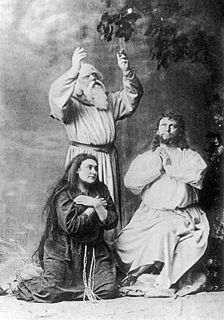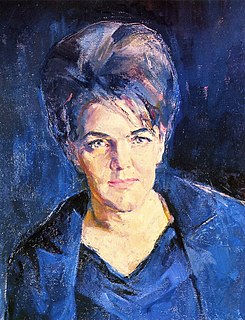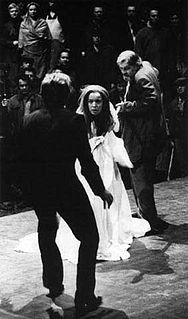
La traviata is an opera in three acts by Giuseppe Verdi set to an Italian libretto by Francesco Maria Piave. It is based on La Dame aux camélias (1852), a play adapted from the 1848 novel by Alexandre Dumas fils. The opera was originally titled Violetta, after the main character. It was first performed on 6 March 1853 at La Fenice opera house in Venice.

Parsifal is an opera in three acts by German composer Richard Wagner. It is loosely based on Parzival by Wolfram von Eschenbach, a 13th-century epic poem of the Arthurian knight Parzival (Percival) and his quest for the Holy Grail.

The Bayreuth Festival is a music festival held annually in Bayreuth, Germany, at which performances of operas by the 19th-century German composer Richard Wagner are presented. Wagner himself conceived and promoted the idea of a special festival to showcase his own works, in particular his monumental cycle Der Ring des Nibelungen and Parsifal.
Jürgen Flimm is a German theater and opera director, and theater manager. After establishing himself as one of the exponents of Regietheater, Flimm was called to manage renowned theaters and festivals. His operatic productions in Germany led to an international career, with operas staged in the Netherlands, Austria, Switzerland, England, Italy, and the United States.

Leopoldine Rysanek was an Austrian dramatic soprano.
Wolfgang Wagner was a German opera director. He is best known as the director (Festspielleiter) of the Bayreuth Festival, a position he initially assumed alongside his brother Wieland in 1951 until the latter's death in 1966. From then on, he assumed total control until he retired in 2008, although many of the productions which he commissioned were severely criticized in their day. He had been plagued by family conflicts and criticism for many years. He was the son of Siegfried Wagner, who was the son of Richard Wagner, and the great-grandson of Franz Liszt.

Wieland Wagner was a German opera director, grandson of Richard Wagner. As co-director of the Bayreuth Festival when it re-opened after World War II, he was noted for innovative new stagings of the operas, departing from the naturalistic scenery and lighting of the originals. His wartime involvement in the development of the V-2 rocket was kept secret for many years.
Regietheater is the modern practice of allowing a director freedom in devising the way a given opera or play is staged so that the creator's original, specific intentions or stage directions can be changed, together with major elements of geographical location, chronological situation, casting and plot. Typically such changes may be made to point a particular political point or modern parallels which may be remote from traditional interpretations.

Adolphe Appia, son of Red Cross co-founder Louis Appia, was a Swiss architect and theorist of stage lighting and décor.

Fritz Busch was a German conductor.

Kurt Overhoff was an Austrian conductor and composer.
Josef Greindl was a German operatic bass, remembered mainly for his performances of Wagnerian roles at Bayreuth beginning in 1943.

Hans Neuenfels is a German writer, poet, film producer, librettist, theatre director and opera director.

Eva Wagner-Pasquier is a German opera manager. She is the daughter of Wolfgang Wagner and Ellen Drexel. On 1 September 2008, Wagner-Pasquier and her half-sister Katharina Wagner were named as joint directors of the Bayreuth Festival which is largely dedicated to the stage works of their great-grandfather Richard Wagner; Wagner-Pasquier resigned from the position in 2015.

The Rhinemaidens are the three water-nymphs who appear in Richard Wagner's opera cycle Der Ring des Nibelungen. Their individual names are Woglinde, Wellgunde and Flosshilde (Floßhilde), although they are generally treated as a single entity and they act together accordingly. Of the 34 characters in the Ring cycle, they are the only ones who did not originate in the Old Norse Eddas. Wagner created his Rhinemaidens from other legends and myths, most notably the Nibelungenlied which contains stories involving water-sprites (nixies) or mermaids of the Danube.

The Jahrhundertring was the production of Richard Wagner's Ring Cycle, Der Ring des Nibelungen, at the Bayreuth Festival in 1976, celebrating the centenary of both the festival and the first performance of the complete cycle. The festival was directed by Wolfgang Wagner and the production was created by the French team of conductor Pierre Boulez, stage director Patrice Chéreau, stage designer Richard Peduzzi, costume designer Jacques Schmidt and lighting designer André Diot. The cycle was shown first in 1976, then in the following years until 1980. It was filmed for television in 1979 and 1980. While the first performance caused "a near-riot" for its brash modernity, the staging established a standard, termed Regietheater, for later productions.
Tobias Kratzer is a German stage director, especially of opera, who has worked internationally after winning a competition in Graz with two entries in 2008. He has staged works by Verdi and Wagner, but also contemporary music. He directed Wagner's Tannhäuser for the 2019 Bayreuth Festival.

Ursula Boese was a German operatic contralto. A member of the Hamburgische Staatsoper from 1960 to 1993, she pursued an international career. She appeared as Stravinsky's Iocaste at the San Francisco Opera in the presence of the composer, as Wagner's Fricka in Wieland Wagner's last production of the Ring Cycle at the Bayreuth Festival, and as Verdi's Ulrica alongside Luciano Pavarotti.
Frank Philipp Schlößmann is a German scenic designer focused on operas who has worked at major opera houses and festivals internationally. He staged Janáček's Jenůfa at the Metropolitan Opera, Wagner's Der Ring des Nibelungen at both the Bayreuth Festival and Der Ring in Minden, and the world premiere of Heinz Holliger's Lunea at the Opernhaus Zürich.

The Bayreuth premiere cast of Parsifal lists the contributors to the new productions of Richard Wagner's inaugural stage play Parsifal, including the premiere, which took place on 26 July 1882 at the Bayreuth Festival.













